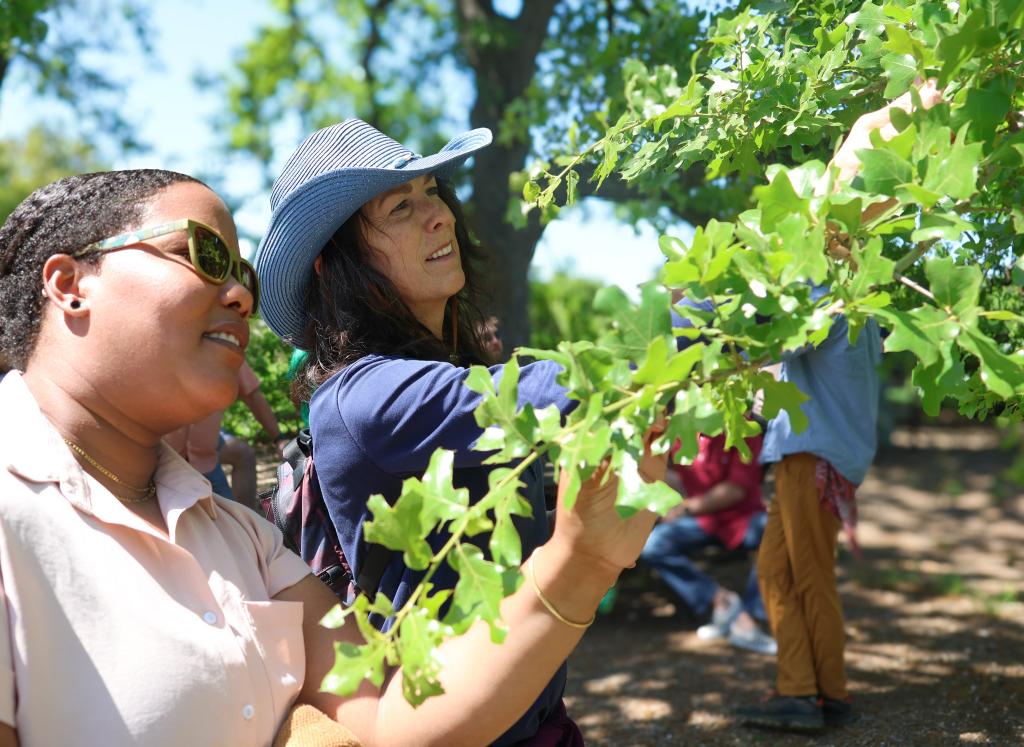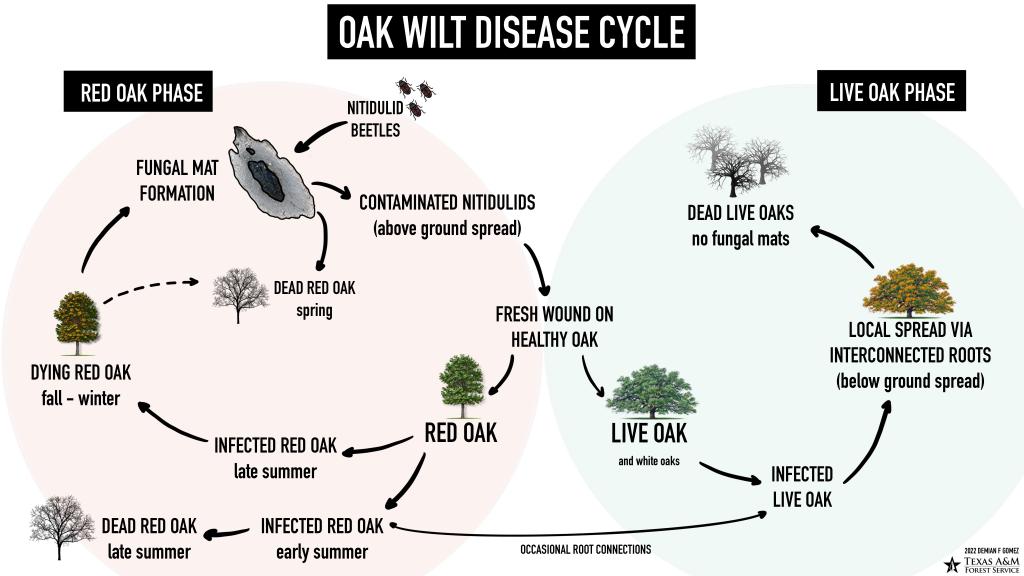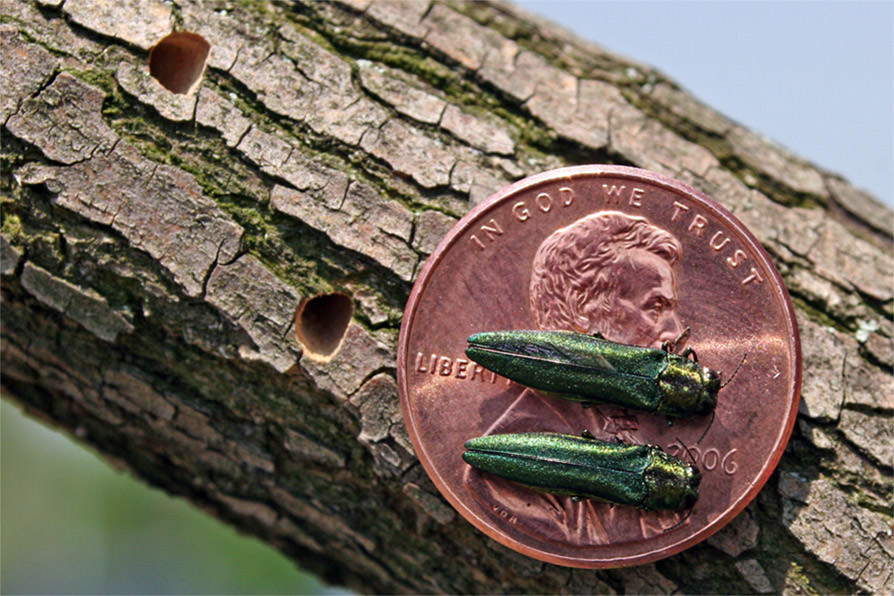Tree Health
The growing, lush tree canopy in Austin is a hallmark for all who live, work, and play in our city. The time and effort to plant and properly maintain trees yield significant benefits.
Trees provide shade in the hot summer months, serve as windbreaks from chilling winds, increase property values, improve human health outcomes, and foster habitats for so many other living organisms. Proper care for a tree can help it thrive and also withstand the stressors of the city and climate. Like humans, trees have basic needs that must be met to survive. Trees may require additional care or professional attention from a qualified arborist.
The information below focuses on tree care and tree health concerns. Here, you can find resources and opportunities to engage with the trees in Austin that make up our urban forest.
Tree Care
Trees in urban environments help to mitigate heat, stormwater run-off, soil erosion, noise levels, and air pollution. To help trees survive Austin’s hot summers and winter storms, here are some things to consider when planting a new tree and caring for trees:
- Drought Tolerance: Choose native or adapted tree species that can handle long periods without rain. The City of Austin’s Grow Green program offers more information about the best tree species for this area.
- Deep Watering: Water deeply and infrequently during dry spells to encourage strong root growth. Early morning watering is best to reduce evaporation. Newly planted trees will need more frequent irrigation for at least two years.
- Soil Health: Improve soil with organic matter and mulch to develop deeper roots that can withstand extreme temperatures. Avoid compacting soil, which can damage deep roots.
- Pruning and Maintenance: Prune trees to develop strong structure that can withstand storms and other extreme events. A qualified arborist can help you develop a plan to reduce or remove weak branches and help strong branches grow more dominant over time. Austin Resource Recovery customers can remove small and large brush through compost collection and on-demand collection.
- Shade and Heat Stress: Trees can get sunburned just like people. Be aware of sudden changes in the amount of sunlight that hits tree trunks, especially on thin or light-colored bark. If you have a newly planted tree, or changes in the landscape have exposed an existing tree to additional sunlight, consider retaining lower branches or adding new plants or other structures to shade against sunscald. As the tree gets larger, the higher branches should eventually help to shade the trunk.
- Diseases and Pests: Most tree pests and diseases are minor issues, but it is important to check regularly for more serious problems. Major concerns like Oak Wilt disease and Emerald Ash Borer only affect certain kinds of trees. Learn about the trees near where you live so you know what to watch for. Consult a qualified arborist to discuss any concerns and help you decide how to manage your trees.
Climate Adaptation
The City of Austin partnered with the United States Department of Agriculture’s (USDA) Climate Hubs and the Northern Institute of Applied Climate Science (NIACS) to assess the vulnerability of Austin’s urban forests and natural areas to climate change. The result was Austin Urban Forest Climate Vulnerability Assessment Report, along with a list of tree species. This report assessed the trees’ vulnerability to likely future climate scenarios. The tree species listed in this report are found in this game set, Arborama! A Tree Game, showing their resiliency, denoted by the background color of the tree species’ game card. Community partners serving the residents of Austin can request a game set for their organization.
Diseases and Pests
There are many diseases and pests that may occupy a tree. Most are minor concerns that will resolve themselves naturally.
Both Oak Wilt (disease) and Emerald Ash Borer (pest), or EAB for short, are of high priority because of their devasting impact on infected trees. According to an analysis of Austin’s urban forest in 2014, ash trees (Fraxinus spp.) make up about 4.2% (1,433,000) of Austin’s urban forest. Live oaks (Quercus fusiformis and Q. virginiana) make up about 8.7% (2,961,000) and red oaks (Q. buckleyi and Q. shumardii) just under 1.4% (467,000). The information provided below may help tree owners and stewards monitor and manage trees affected by these concerns with the most appropriate steps.
For active neighborhood organizations (NAs and HOAs) concerned with oak wilt and EAB, consider the Neighborhood Forest Health Assessment project listed on the Urban Forest Grant web page. For information on other forest health issues, visit Texas A&M Forest Service’s Forest Health.
Oak Wilt
Oak wilt is a fungal disease that spreads from infected to healthy oak trees by way of interconnected root systems (underground) and sap-feeding beetles that transport the fungal spores (above ground). Learn to identify oak trees to help with monitoring for oak wilt. Contact a qualified arborist if you suspect oak wilt in your tree to help develop an appropriate management plan. For any concerns surrounding a public tree (City-owned), use Austin 3-1-1 to report it. Information on oak wilt can be found on the City of Austin’s website. Additional information, along with how to get help with confirming and managing this disease, is found on the Texas Oak Wilt website.
Oak wilt can spread underground through root grafts or through the air by insects carrying fungal spores.
Image courtesy Demian Gomez, Texas A&M Forest Service.
Emerald Ash Borer
EAB is a non-native pest threatening ash trees in North America. Adult EAB are metallic green and about a half inch long. Female adults lay approximately 60-90 eggs in the crevices of an ash tree’s bark with the larvae feeding on the tree beneath the bark. They chew tunnels through the wood, cutting off the tubes that carry water to the leaves and eventually killing the tree. The adult EAB leaves distinct, D-shaped exit holes in the bark and can fly at least a half mile from the ash tree where it emerged.
EAB originated from Asia and was discovered in Michigan in 2002. Since then, EAB has spread across the country, reaching Texas in 2016, and continues to spread south within the state. The most recent confirmed report of EAB in proximity to the Austin area was in July 2025 in Bell County (county seat: Belton, TX). As of mid-2025, there has been no positive identification of EAB in the Austin area, but Texas A&M Forest Service continues to monitor EAB activity along the IH-35 corridor.
Emerald Ash Borer is a small, shiny, green insect. It tunnels through branches as a larva and emerges as an adult, leaving D-shaped holes in the bark.
- Learn: EAB Network provides information about EAB directly on the website or through listed links to other sources.
- Monitor: USA National Phenology Network (NPN) have developed phenology forecast maps that predict when EAB adults may emerge and EAB eggs may hatch. Explore the maps, monitor ash trees during the forecasted life cycle period, and report any suspected EAB activity.
- Report: If you suspect EAB in your ash tree, please call the national EAB hotline at (866) 322-4512.
Resource Library
A curated list of tools and resources all geared towards stewarding and managing trees are found below by format or type.
- Local Resources
-
- Think Trees Tour – A digital experience to learn more about tree species found in public spaces through self-guided tours of libraries and other public spaces.
- Austin’s Tree Canopy – A guide to understanding tree canopy cover in Austin, Texas.
- Tree Information Center – A hub of resources by topic and audience.
- Urban Forest Grant – Grant funding may be available for eligible public tree care and tree education projects.
- Austin 3-1-1 – Get answers to City-service questions or submit requests and concerns for City departments by calling or using the app 24 hours a day, 7 days a week, and 365 days a year.
- Articles, Manuals, and Reports
-
- Tree Owner’s Manual – This document provides information on buying, installing, and maintaining a tree.
- Healing Power of Trees Article - The Nature Conservancy published a magazine article highlighting a project demonstrating improved health conditions when 8,000 trees are planted.
- USDA Climate Hubs Vulnerability Assessment – This assessment evaluates the vulnerability of Austin’s urban forest and natural areas to future climate scenarios.
- Climate Adaptation Actions for Urban Forests and Human Health Report – This report includes “information and ideas for optimizing the climate and human health outcomes of urban forestry projects...” through adaptive planning and activities.
- Maps and Apps
-
- iNaturalist – Share observations of organisms and crowdsource identifications, among other features.
- Texas A&M Forest Service TreeMD – A starting point for diagnosing a problem with your tree.
- EDDMapS – The Early Detection & Distribution Mapping System (EDDMapS) is a user-friendly tool to document and monitor invasive species.
- Tree Equity Score Analyzer (TESA) – Assess and enhance the tree canopy at the neighborhood and property-level using the embedded tools. A product by American Forests.
- Public-Owned Trees in Austin (TreePlotter) – Navigate the map to view public trees' location, species, measurement, and climate vulnerability. Note that this inventory is not yet complete.
- Tree Canopy [dot] US – Assess and monitor community tree canopy using this software application produced by the Arbor Day Foundation in support with USDA Forest Service and PlanIT Geo.
- Environmental Insights Explorer (Google) – View and download the data estimates on emissions, tree canopy, and rooftop solar potential.
- NatureScore Map – NatureScore presents a map measuring “the amount of health supporting natural elements for any location or polygon and provides a numerical scale that ranges from 0 (largely built, less healthy environment) to 100 (largely natural, healthy environment).”
- My City’s Trees – Access Urban Foresty Inventory and Analysis (FIA) data to view or generate reports of Austin’s urban forest.
- Urban Forest Stats – This tool provides summaries of estimates based on sampling produced by Urban Forest Inventory and Analysis (FIA) data.
- i-Tree – A software suite of free tools to assess and manage trees.
- Other Tools
-
- Vibrant Cities: Urban Forestry Toolkit – The U.S. Forest Service step-by-step guide to implementing urban forestry in your community.
- 3-30-300 Rule – An evidenced-based set of guiding principles for healthier cities.
- LA Micro Forests – A free guide to installing a micro forest using the Miyawaki Method, adapted to Los Angeles, CA.
- Healthy Trees, Healthy Lives – Research and resources connecting trees to human health.
- Wildfire Hub – Learn from the City of Austin’s Wildfire Division about wildfire risk in Austin and how to make your property more resistant to wildfire. Request a free Structure Ignition Zone Evaluation from a Wildfire Specialist, who can provide tailored recommendations for your property.
Community Engagement
Discover opportunities to engage with Austin’s urban forest both as an explorer and steward. The first section lists pathways for supporting the efforts of caring for trees. The second section lists some prime examples of local, collaborative activities to steward the landscape.
- Explore and Support
-
- Report City-owned tree issues or get answers to City-service questions through Austin 311 by phone or app 24/7/365.
- Identify trees and share information on iNaturalist.
- Request a urban forest speaker for a community group.
- Take the Urban Forest Stewards Program online (self-pace) and obtain certification from TreeFolks.
- In Development – Coming soon! Serve as a Tree Ambassador to help amplify social messaging.
- Participate and Steward
-
- Join the community-led efforts of Austin Parks Foundation’s It’s My Park Day to improve parks and green spaces throughout Austin.
- Participate in a guided hike or volunteer with Austin Water Wildland’s events such as Forest Restoration.
- Access invasive species tools and contribute to documenting and monitoring invasive species using EDDMapS.
- As a community organization, consider eligible tree-related projects and apply for an Urban Forest Grant.
- Become a Tree Ambassador of Austin's urban forest to help grow stronger, healthier, and greener neighborhoods.
Together, we can build a strong, healthy urban forest that will continue to benefit Austin for generations to come.
Visit the Tree Information Center for more tree and tree-related resources.




